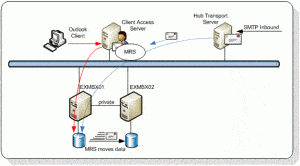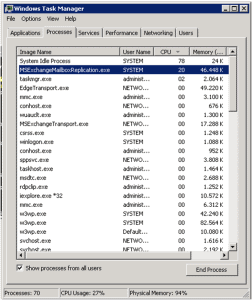With the new online Move-Mailbox functionality in Exchange Server 2010, invoked by calling the New-MoveRequest cmdlet, the time a mailbox is offline has been reduced to only seconds, and as such the end-user experience has been greatly improved.
This is what actually happens when an Exchange administrator initiates a New-MoveRequest, either from the Exchange Management Shell or the Exchange Management Console when moving a mailbox from EXMBX01 to EXMBX02 in the figure below.
The process of moving mailboxes is now performed by a service called Mailbox Replication Service or MRS. The MRS is running on the Client Access Servers.

- The Administrator initiates a move request like New-MoveRequest -Identity J.Wesselius -TargetDatabase EXMBX02\MDB02. Now a special message is placed inside the System Mailbox of the current Active Directory site. This message tells that the Move Request is initiated and that its status is Queued;
- The Mailbox Replication Service periodically scans this System Mailbox for these messages. The MRS will find the message and reads that the J.Wesselius mailbox is Queued;
- The MRS will update the System Message to “In Progress” and will start moving the Mailbox data from EXMBX01 to EXMBX02. MRS will keep the old and the new mailbox in sync. The user is still connected via the CAS Server to EXMBX01, and arriving messages will be delivered via the Hub Transport Server to the Mailbox on EXMBX01;
- At a certain point when almost all data is moved from the old to the new Mailbox the old Mailbox is locked. The last pieces of data are moved from the old to the new Mailbox. Also the Active Directory properties of the user are changed to point to the new Mailbox Database. At this point the status of the Move Request (i.e. the message is the System Mailbox) is changed from “In Progress” to “Completion in Progress”;
- The new Mailbox is activated, the old Mailbox is soft deleted (which means that it is actually recoverable in SP1!) and the user needs to restart his client. When you move a Mailbox from an Exchange 2010 SP1 Mailbox Database to a Mailbox Database on another SP1 Mailbox Database the client does not need to be restarted.
- Although the Mailbox is moved from server EXMBX01 to EXMBX2 the Move Request itself is not deleted. This has to be performed by the Administrator, either by using the Exchange Management Shell (Remove-MoveRequest) or by using the Exchange Management Console.
You can see the MRS run on the Client Access Server in the Windows Task Manager:

You can see the status of the move request by entering the following command in the Exchange Management Shell:
[PS] C:\download>Get-MoveRequest | ?{$_.status -eq “InProgress”}| Get-MoveRequestStatistics | ft Disp*,Per*,BytesTransferredPerMinute
DisplayName PercentComplete BytesTransferredPerMinute
—- —– ———
Jaap Wesselius 66 134.2 MB (140,668,124 bytes)
Katie Price [HR Department] 66 119.9 MB (125,677,306 bytes)
[PS] C:\download>
The MRS is a throttled service, and it is fully configurable. There’s an MSExchangeMailboxReplication.exe.config file in the “C:\Program Files\Microsoft\Exchange Server\V14\Bin\” directory. You can use this config file to configure the throttling of the MRS by changing these entries:
- MaxActiveMovesPerSourceMDB
- MaxActiveMovesPerTargetMDB
- MaxActiveMovesPerSourceServer
- MaxActiveMovesPerTargetServer



Load comments